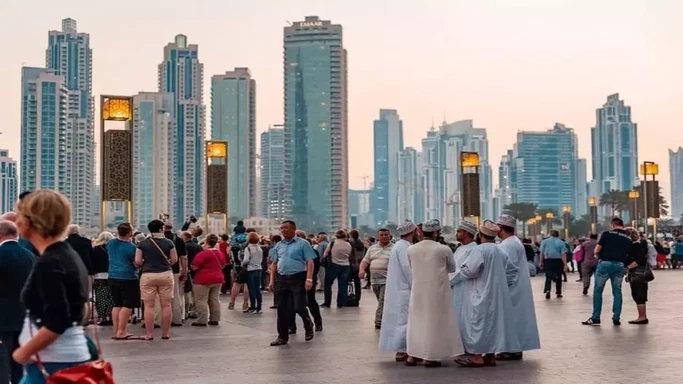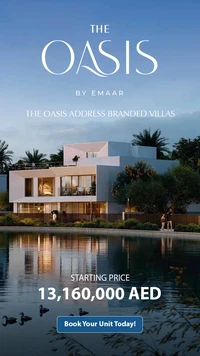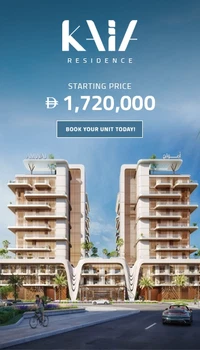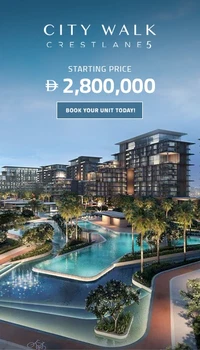Dubai is among the most popular Emirates in the United Arab Emirates, exhibiting excellent economic growth. Consistent population increase has also been a significant factor in Dubai. Besides the City's local population, Dubai has become a hub for expatriates and foreign investors.
Dubai's immense population consists of expats with diverse nationalities and backgrounds who are attracted to the City's luxurious lifestyle, exclusive towers, panoramic skylines, and seamless provision of visa pathways.
Let's delve into this comprehensive analysis to explore more about Dubai population growth in 2025 by examining growth patterns, demographics, and the distribution of nationalities.
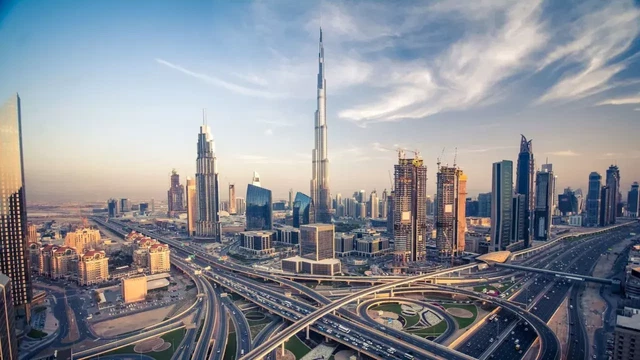
Dubai Population in 2025: An Overview
The 3rd quarter of Dubai population in 2025 has seen enough! The report released by Khaleej Times declares that Dubai is currently growing in population at the highest pace in the City's entire history.
As per the reports by DXB Interact, the population currently contains around 4,019,195 people, marking a 5.92% annual surge. The population reports for September 2025 further indicates a tremendous addition of 223,000 new residents in one year.
The influx of Dubai population is the result of the continuous flow of investors and foreign workers into the City. This constant growth showcases the City's enticing characteristics, making tourists, businesses, and expats flock to the City. Furthermore, Dubai is renowned not only for its economic and investment opportunities and amplified infrastructure but also for serving as the gateway between the East and the West.
Additionally, the increase in the population has also augmented the demand for rental properties as well as end-user properties. The annual inflation rate in Dubai decelerated to 2.3%, following the drop in fuel prices. However, housing developments remain a prime driver.
Dubai Statistics Centre has issued a report declaring an average inflow of new residents every month, while the population of Dubai has grown from 3.79 million in 2024 to 3.95 million in 2025. The following year, the influx of foreign workers is expected to decline; however, the migration rate has remained consistently high over the previous three years.
If you want to buy property in Dubai, here's the top suggestion for you:
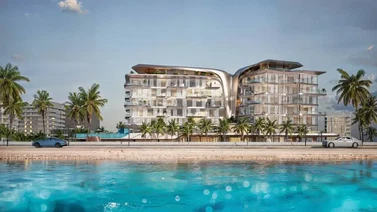
Starting from AED 1,050,000
Do Hotels & Residences by One Development
Dubai Islands
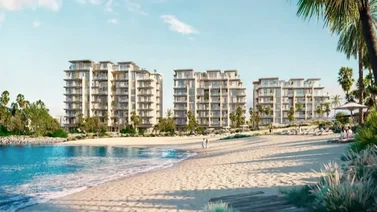
Starting from Updated soon
Solaya By Meraas
Jumeirah
Key Drivers of Population Growth in UAE
Dubai population has been driven by various factors, so it would not be erroneous to adduce that Dubai is a city with a growing population and amplifying attractions, advancing a desire amongst foreigners to come and inhabit this city.
1. Economic Opportunities
The economy of UAE's most famous Emirates is diverse, expanding industries such as real estate, finance, trade, and tourism. The economic dynamism allures workers, skilled professionals, and investors from around the world, which is not only a contributing factor to Dubai's economy but to Dubai's population as well.
According to the International Monetary Fund's reports, inflation in the UAE is expected to remain contained at around 2.0 percent in 2025, despite higher housing and utilities-related costs. Khaleej Times further reported a 45% surge in the UAE’s non-oil exports, signaling its reduced dependence on the oil-based economy.
2. Lifestyle and Infrastructure
The boastful infrastructure of Dubai is the second factor contributing to driving the City's population. It demonstrates world-class healthcare, infrastructure, entertainment, education, and hospitable facilities, stimulating foreigners to relocate to Dubai
Dubai is a renowned global hub with top-notch amenities and extensive facilities. Stimulating a desire to relocate amongst foreigners, Dubai shares a leading location for people to migrate, reside, and work. Embarking on a seamless transformative journey, this part of the Emirates is ambitious to progress in the construction sector.
The brilliant construction market of Dubai is estimated to grow from USD 41 Billion to USD 50.4 Billion in 2029. Shifting imaginations into reality hence, attracting expats to Emirates results in an immense population.
3. Strategic Location
Dubai is located at the crossroads of Asia, Europe, and Africa, demonstrating a convenient base for international travelers and multinational companies.
Dubai's gateway location has provided a natural link, making communication and transference easy and flexible between manufacturers, producers, and consumers. This makes Dubai an ideal choice for business owners and investors to live and work.
4. Immigration Policies
Dubai extends great yet innovative immigration policies and includes a number of forward-looking initiatives to attract skilled talent and foreign investment from around the world. With over 142,000 high-net-worth individuals expected to move to Dubai in 2025, the city is at the top of the global high-net-worth migration.
The most attractive visa options such as long-term visas for expatriates, the 10-year Golden Visa, as well as other visa alternatives for entrepreneurs, freelancers and retirees, have fostered immigration in the country.
These initiatives keep Dubai a talent magnet, providing security, stability, and prospects for advancement. Not only do these policies strengthen the economy, but also, encourages more individuals to migrate, causing the city to grow in population even more.
5. Cultural Diversity and Tolerance
Dubai creates a welcoming environment for visitors looking to immerse themselves in a diverse culture. According to the latest report by Global Media Insight, Dubai hosts residents and professionals from over 200 nationalities.
The UAE's generally liberal attitudes towards social issues make Dubai an attractive proposition for many expatriates, and have helped its population to grow rapidly.
Dubai Demographics 2025
Dubai is a melting pot of nationalities and cultures, bringing diverse and dynamic expats from other countries to amalgamate the City's iconic landmarks. Dubai's demographics represent the city's cosmopolitan nature by fusing people from different backgrounds together.
The expatriate community, however, contributed significantly to the population in Dubai. Below is the comprehensive breakdown of Dubai Demographics in 2025.
1. Gender Distribution
Most of the expatriate workforce reside in Dubai, while their families live in their homelands. Hence, a significant skew is observable in the City's population by gender distribution, where the male population predominates over the female population. As of Dubai Demographics 2025:
- Females cover approximately 31.40% of the entire population of Dubai - about 1.21 million.
- Male gender comprises 68.60% of the overall population of Dubai -roughly 2.63 million in total.
This lopsided imbalance is persistent due to the high influx of male workforce in the trade, construction, and several other industries.
2. Age Distribution
Navigating the population of Dubai by age, most of the inhabitants are young while a significant section of the population belongs to the working age group. The age distribution in 2025 is given below:
- 0-14 years – 14.79%
- 15-24 years – 11.16%
- 25-54 years – 68.97%
- 55-64 years – 3.93%
- 65 years & beyond – 1.15%
The magnified rate of individuals aged 25-54 signifies Dubai's captivating presence of a working environment, alluring entrepreneurs, and skilled professionals in the City.
Dubai Population by Nationality 2025
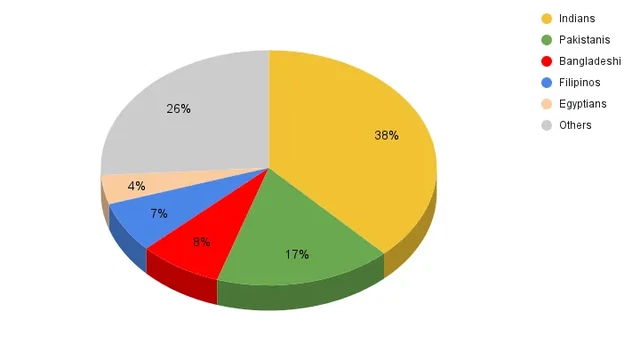
Involving a myriad of nationalities, Dubai demonstrates an upward trajectory, with expats in the majority. The dynamic working atmosphere of Dubai has enticed expatriates from different countries while fusing them into the City's multicultural environment.
Though the official religion of the Emirates is Islam, welcoming circumstances have brought diversity in religion. Currently, Dubai consists of minorities following different religions, such as Hinduism, Christianity, Buddhism, and Sikhism.
In addition to Arabic (the official UAE language), English, Urdu, Hindi, Chinese, Persian, Tagalog, Tamil, and Bengali are commonly spoken in Dubai. Dubai has crafted a commendable sense of diversity, unifying diverse nationalities at one working, living, and entertainment platform.
1. Dubai Expat Population
Over 92.02%, accounting for 3.53 million population, is blanketed by expats in Dubai, with major expat groups including:
Indians: Indians comprise the massive population portion in Dubai, with an estimated constitution of around 27.49% of the overall population across the UAE. Numerous Indians work in sectors such as healthcare, construction, trade, and IT.
Pakistanis: The second largest expat group in Dubai is the Pakistani community, making up around 12.69% of the total population of the UAE. The sectors like retail, transportation, and construction involve the Pakistani workforce.
Bangladeshi: Approximately, 7.38% of the total population is covered by Bangladeshis, whereas, their engagement is particularly shown in service and construction sectors.
Filipinos: Filipinos represent 5.56% of the overall population and are involved in domestic and other professional sectors for livelihood.
Egyptians: Constituting around 4.23% of the population, Egyptians are employed domestically in the healthcare and hospitality sectors.
Other Nationalities: The remaining expat population in Dubai is occupied by various other nationalities, including Somalia, Canada, The United States of America, and the United Kingdom.
2. Emirati Population
While expats form the major population of Dubai, the Emirati population comprises a smaller section of Dubai. Besides covering a small population density, the role of the Emirates is highly crucial to the City's economic and social fabric.
An estimated 7.98% of the City's total population is covered by Emiratis; however, the Government of Dubai has consistently encouraged Emiratisation policies to amplify UAE residents' participation in the City's economic development and workforce.
Here are latest off-plan projects in Dubai recommended for you:
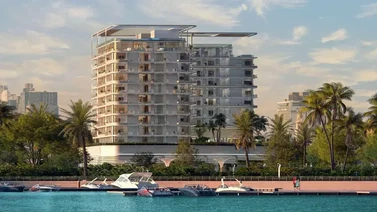
Starting from AED 1,750,000
Arka Enclave by Atmosphere Living
Dubai Islands
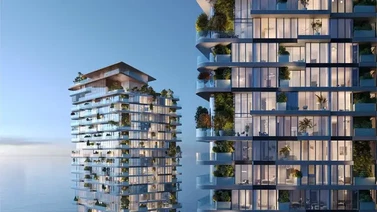
Starting from AED 2,530,000
Soulever by Beyond
Dubai Maritime City
Dubai Population Growth
Dubai population growth has remained terrific over the last few decades. The population surged to approximately 3.95 million, according to the official Statistics revealed by the Dubai Statistics Center. UAE was born out of a "Trucial Treaty," and since its liberation from the British, the Emirates promised to thrive and compete with major global hubs in all aspects of economy, society, and infrastructure.
The City's urban core has significantly enhanced the appeal to bring foreign investment excessively. Moreover, the City's renowned landmarks and award-winning projects have earned it the title of Gigantic Infrastructural Centre. Continuously making its way up to the robustness, Dubai has transformed into a global destination with favorable locations occupied by expatriates.
Furthermore, the government of Dubai is boosted to bring initiatives that align with contemporary demands and attract foreign investors. Such initiatives include Golden Visa, long-term residency visa, and retiree visas, which have specifically contributed to the sustained population growth in Dubai.
Dubai Urban Vs. Suburban Population
Let's get intricately involved in the City's population spread, which varies across different locations in Dubai. Compared to the suburban areas that lie on the outskirts of the city, urban core areas showcase a high population density due to the centralization of commercial and residential projects.
1. Key Urban Areas in Dubai
Dubai Marina: A multipurpose community nestled in the heart of Dubai, Dubai Marina offers an exhilarating experience and is ironically popular amongst expats. Concentrated on its waterfront views, Dubai Marina integrates commercial, residential, and leisure facilities.
Downtown Dubai: Renowned for its staggering skyscrapers and key attractions like Dubai Mall, Dubai Fountain, and Burj Khalifa, Downtown Dubai is a bustling urban core with a high population density.
Business Bay: A rapidly advancing business community, Business Bay is a center of professional and skilled workers and entrepreneurs associated with finance, real estate, and relevant sectors.
Palm Jumeirah: Real estate in Palm Jumeirah caters to high-net-worth individuals and continues to be in high demand, while property prices are also driven by its beachfront location as well as proximity to business hubs.
2. Sub-Urban Areas in Dubai
Dubai Silicon Oasis: A techno-driven community offering residential units that cater to the workforce in the tech sector, it is the most sought-after community after urban cores and involves a good proportion of the population.
Arabian Ranches: Designed to cater to families, Arabian Ranches is a suburban development. The community offers a blend of leisure facilities, parks, and expansive villas.
Jumeirah: A well-crafted residential community popular for its proximity to the beach and spacious villas, Jumeirah offers residents a comfortable lifestyle in contrast to the urban area.
Al Barsha: Al Barsha offers a family-friendly neighbourhood at a more affordable price point than areas like Downtown or Dubai Marina. Al Barsha has grown with a number of residential developments in the area, and is still attracting expats looking for affordable housing.
Forecasted Population Growth
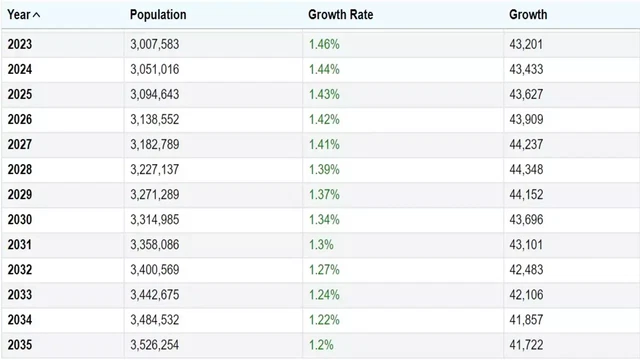
The population of Dubai is projected to continually surge in the coming years, as observed in the light of strategic initiatives and current economic development. By 2030, the City's population is expected to rise beyond 5 million. This expansion is estimated to boost due to various factors:
1. Legacy of Expo 2020
The pandemic in the world brought a new venue in Dubai- The Expo 2020. The Expo 2020 was held in 2021 and has left a legacy in the long run. Dubai demonstrated its capabilities on a global platform through Expo 2020, alluring millions of visitors. Moreover, many developments associated with the Expo continued to serve as a potential population growth factor.
2. Vision 2040
Vision 2040 outlines an extensive plan for sustainable urban development. The plan's primary focus on the standard quality of life has started to entice more businesses and residents, which will further boost the population expansion.
3. Dubai Economic Agenda 2033
Dubai Economic Agenda 2033, which aims to expand Dubai’s trade network to 400 cities, attracting more investors and opening new trade channels. It will create jobs, turn the economy with new businesses. This will inevitably attract professionals and entrepreneurs looking to benefit from the opportunities brought on by Dubai’s new landscape.
Continued economic expansion and increased foreign investment will fuel population growth, cementing Dubai’s position as a global trade hub and creating a diverse, multicultural society.
Have a look on some of the best properties in Dubai:
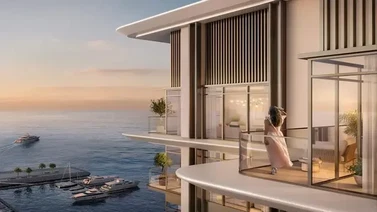
Starting from AED 2,300,000
Aurea by Emaar
Mina Rashid
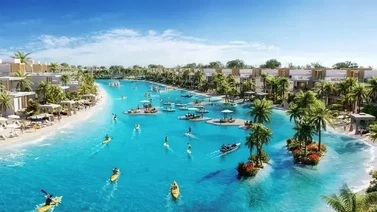
Starting from AED 2,750,000
Damac Islands Phase 2
Dubailand
Challenges & Opportunities
Dubai's dynamic economic stability and expansion present both a challenge and an opportunity for the City. Catering to the demands of the enlarging population requires meticulous planning and potential investment in services, sustainable development, and infrastructure.
1. Economic Diversification
Acknowledged as an oil and gas-producing country, the UAE has managed to diversify its economic aspects. This initiative rapidly elicits attraction amongst investors in all sectors, including education, healthcare, renewable energy, and technology.
2. Housing and Real Estate
The growing population demands housing management plans. Thus, the City ensures the availability of reasonable housing options with multiple off-plan projects. The diverse housing solutions offer both luxury duplexes and affordable havens.
Closing In
Standing at approximately 4 million in Q3 2025, Dubai population is a highly concentrated topic amongst analysts and administrators. The continuous expansion of the population demonstrates the City's magnificent attraction; however, it also exhibits a likelihood challenge to manage the demands that grow with the growing population.
Moreover, the immense population of the expatriate community drives diverse demographics in the region, crafting a multicultural environment.Ensuring sustainable development in the ever-evolving environment of Dubai has become a key factor to address. However, the government of Dubai promises to sustain the vibrancy of the lifestyle of its residents through the City's ambitious visions and strategic programs.
Acknowledging the population dynamics in 2025 brings valuable insights into the City's current and future situations. Also, the intricate information on Dubai's growth patterns, demographics, and prospected expansion highlights the remarkable journey attained by Dubai. It demonstrates Dubai's continued pursuit of excellence via different economic and infrastructure projects.
Disclaimer:-The information presented here has been gathered from various reliable sources. However, please note that there may be minor changes in population statistics.
Explore More About Dubai...
